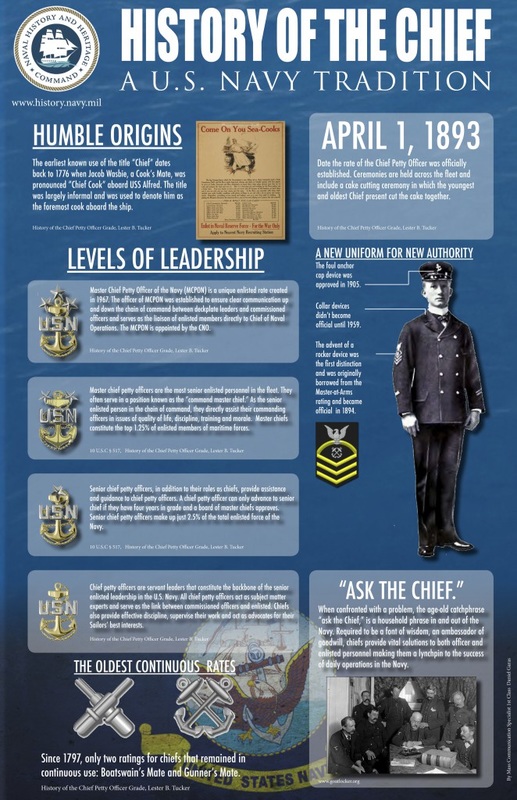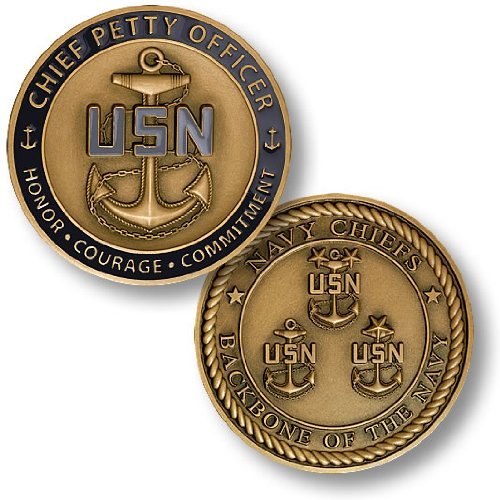“ I hardly know, sir, just at present..." ― Lewis Carroll, Alice in Wonderland
The Chief Petty Officer's Motto:
RESULTS. NOT EXCUSESThe rank of chief petty officer as it is recognized today was officially established April 1, 1893. As servant-leaders, they acted as the unique lynchpin between officers and enlisted personnel who executed daily operations, and also took a leading role in the career development of junior petty officers. Additionally, chiefs were celebrated not only for their technical expertise, but their administrative abilities as well.
Knowledge in the intricacies of the ship’s daily operations and ability to coordinate with various departments gave chiefs unique abilities that were unrivaled by even the most senior officers. Additionally, chiefs were given their own space on ships. Referred to as the “Chief’s Mess,” it is off-limits to anyone else (officer or enlisted) without invitation and is affectionately called the “Goat Locker.” Up until the Second World War, chiefs evolved into disciplinarians that exercised and dispended a great deal of unwritten naval law. According to “The Role of the Chief Petty Officer in the Modern Navy” by Don A. Kelso, “they served as exacting supervisors, highly proficient specialists and acted as advocates to higher authority.” After World War II, the demobilized Navy was left with a top-heavy organization that frequently utilized chiefs in billets normally filled by junior petty officers. “The chief petty officer is responsible for three facets of leadership relative to the men placed in his charge,” Kelso writes. The effective discipline of their Sailors, the effective supervising of the work their Sailors perform, and finally, to act as an advocate for their Sailors’ best interests. These repurposing efforts of the past have carried on reflecting the chief of today’s Navy. Chief petty officers fulfill a vital function in the operation of the Navy’s military and work schedule. Drawing on their past, they serve as technical experts, act as the liaison to commissioned officers and possess the ability to establish and maintain the conditions that provide Sailors with opportunities for success. The ability to bridge the gap and provide solutions to both officers and enlisted personnel makes them not only silent professionals, but also ensures the old mantra, “ask the Chief,” shall remain a vital part of the Navy well into its future. Guiding Principals of a Chief Petty OfficerNo person is more professional than I. I AM a Chief Petty Officer, a leader of people. As a Chief Petty Officer, I realize that my number one priority is to accomplish the mission. I am proud to be a Chief Petty Officer and will at all times conduct myself as to bring credit upon myself, the command, the Navy and my country. I will accept responsibility of and accountability for my actions. I will do "what is right" based on individual circumstances.
Competence is my watchword. I will strive to remain technically and tactfully proficient. All sailors are entitled to outstanding leadership; I will provide that leadership. I know my people and will always place their needs above my own. I will communicate consistently with my people, be fair and impartial when recommending both awards and punishment. I will train, guide and mold junior officers. I will evaluate people based on personal worth. As a Chief Petty Officer I will work to earn the respect and confidence of officers and my people. I will be loyal to those with whom I serve; seniors, peers and subordinates alike. I will exercise initiative, by taking appropriate action in the absence of orders. I will not compromise my integrity, nor my moral courage. I will not forget, nor will I allow my comrades to forget, that we are professional Chief Petty Officers - Leaders of people. The Chief's Petty Officer's Pledge
|
Silent ProfessionalsHistory of the Rank
BY U.S. NAVY Effectively running and fighting a warship relies on bridging the gap between officers and enlisted personnel. It was from this need that the creation of the rank of chief petty officer was born. U.S.N. -
|


